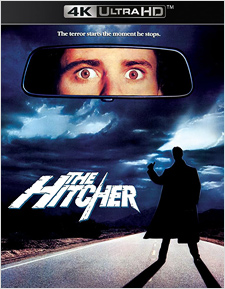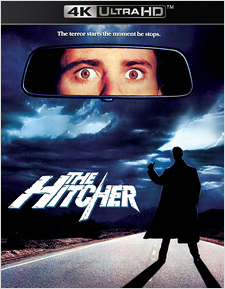Hitcher, The (Warner Bros.) (4K UHD Review)

Director
Robert HarmonRelease Date(s)
1986 (October 22, 2024)Studio(s)
HBO Pictures/Silver Screen Partners/Tri-Star Pictures (Warner Bros. Discovery Home Entertainment)- Film/Program Grade: A-
- Video Grade: A
- Audio Grade: B+
- Extras Grade: C+
Review
On a lonely West Texas highway, young Jim Halsey (C. Thomas Howell) is about to face the most difficult test of his life. Jim has taken a drive-away job, hired to deliver a car from Chicago to its owner in San Diego, California. While driving through the remote desert in the evening rain, he comes across a soaked hitchhiker on the side of the road and—against his better judgment—decides to stop and pick him up. The newcomer, John Ryder (Rutger Hauer), seems a bit of an odd duck, initially resisting Jim’s efforts at conversation. But when he does finally reveal his true nature and intentions, it soon becomes clear that Ryder is a very dangerous man at the least… and quite possibly a homicidal maniac.
At knifepoint, Ryder tells Jim to say, “I want to die.” Instead, Jim manages to eject Ryder from the car. Little does Jim know though that there’s no escaping Ryder, who takes a singular interest in him. It seems that Jim has done the one thing that none of Ryder’s other victims has ever dared to try: fight back. So Ryder decides to see just how far he can push Jim… and just how far the young man will go in order to survive. In so doing, Ryder leaves a messy trail of carnage and blood that quickly attracts the attention of the local sheriff’s deputies, who mistakenly pin these crimes on Jim. And the only person who’s sure that Jim is innocent is a young woman named Nash (Jennifer Jason Leigh) who he meets at a roadside diner along the way.
Directed by Robert Harmon, The Hitcher is one of many films in the 1980s to sneak under the radar upon its initial release. Produced by HBO Films and Silver Screen Partners, TriStar Pictures was contractually obligated to distribute the film, which received terrible reviews from critics for being too violent and sadistic. But the film took in over $2 million in its opening weekend, and went into extensive rotation on HBO, which is where most people eventually experienced it for the first time. Those who did see The Hitcher found it to be a compelling suspense thriller which, though certainly violent, is much more psychological than overt. The thing is, nearly all of the actual violence here happens off screen. This isn’t a film where you see heads being lopped off or people being stabbed—all you actually see is blood and bodies in the aftermath. That, of course, has the effect of making it all somehow much more scary.
Comparisons have been drawn between this film and Steven Spielberg’s Jaws and Duel, and there’s certainly some merit to the idea. There isn’t a lot of real-world logic to Ryder’s actions, and the way he manages to appear out of nowhere at just the right time to most effectively cause chaos is uncanny. But it seems to me that Ryder isn’t actually meant to be a real-world figure. Like Bruce the Shark or the truck in Duel, it’s as if Ryder is instead some kind of existential force… a demon condemned to walk the Earth murdering, until he meets someone who might be strong enough to actually stop him.
A simple as the film’s plot might be, The Hitcher benefits greatly from terrific performances by Howell (well known to audiences at the time as a neighborhood friend in E.T. the Extra-Terrestrial, Ponyboy in The Outsiders, and one of the fighting Wolverines in Red Dawn), not to mention a thrilling turn by Hauer (fresh from playing the terrorist Wulfgar in Nighthawks and of course Roy Batty in Blade Runner—by far his most iconic and memorable role). Leigh also adds a surprisingly gritty and humane quality to the proceedings as Nash, and a handful of good character actors (including The Walking Dead’s Jeffrey DeMunn, JAG’s John M. Jackson, and Star Trek: Deep Space Nine’s Armin Shimerman) round out the ensemble. Best of all, in my estimation, Harmon’s first-time direction is effective, the cinematography by John Seale (Witness, The English Patient, Mad Max: Fury Road) is sublime, and the score by composer Mark Isham (A River Runs Through It, October Sky, The Majestic) is sparse and effective.
The Hitcher was shot on 35 mm photochemical film by Seale using Panavision Panaflex Gold cameras with Panavision E-Series anamorphic lenses. It was finished photochemically and released theatrically in the 2.39:1 scope aspect ratio. For its release on Ultra HD, Second Sight in the UK partnered with Warner Bros. (which owns the film through HBO) to commission a new 4K scan of the original camera negative. Second Sight then completed an extensive digital restoration and HDR grading, in a process supervised by Harmon. And in exchange for allowing access to the negative, Warner Bros. here in the States has released their own 4K edition using the same remaster. (Note that this US release was supervised by the team at the Warner Archive Collection.) The resulting 4K image is compatible with viewing in Dolby Vision HDR and HDR10, and it’s been encoded on a 100GB disc for maximum data rates—80-90 Mbps on average (with peaks well over 100 Mbps). The 4K image is gorgeous, with tremendous detail, impressive texturing, and light-medium and ever-present grain. The HDR grade offers incredibly deep shadows—occasionally a little bit crushed, but that’s in the negative—as well as bold highlights. Best of all, the film’s palette is broader and more nuanced than ever before. Everything appears natural here, from skin tones and skies (whether blue and sunny or overcast), to crimson sunsets, and desert landscapes and foliage—all of it looks fantastic. Occasional limitations in the negative prevent this image from achieving true reference quality, but as someone who watched The Hitcher repeatedly on 4x3 SDTV via pay cable back in the day, I would never have imaged that this film could look so good. This remaster is absolutely beautiful.
Audio-wise, Warner’s 4K disc offers the film’s primary English audio in the original 2.0 stereo in lossless DTS-HD Master Audio format, as well as a new Dolby Atmos mix (both identical to the tracks offered by Second Sight). The clarity of each is excellent, with the stereo obviously a little more forward sounding and the Atmos providing a bit of additional immersion. The surround effects via Atmos are very natural and restrained however—not flashy in any way—which draws you into visuals without sacrificing the sonic character of the original stereo experience. Isham’s score is also particularly well staged in the Atmos mix, which enhances the film’s neo-noir tone and atmospherics. Whichever mix you choose, I think you’ll be pleased. Bass isn’t what I would call robust or blustery, but it’s true to the original experience and more than sufficient. Optional English SDH subtitles are also provided.
Warner’s 4K disc includes the film in Ultra HD only—there’s no Blu-ray copy included here, though a remastered Blu-ray (sourced from the new 4K master) is also available separately from WBDHE. The 4K disc includes the following extras:
- Audio Commentary with Robert Harmon and Eric Red
- Bullseye: An Interview with Director Robert Harmon (HD – 41:29)
- Theatrical Trailer (HD – 1:28)
Obviously, this is only a fraction of the content found on Second Sight’s UK import release (reviewed here at The Bits), but it’s also much more affordable, not to mention more widely-available here in the States. Included is the original DVD commentary, the new interview with the director produced by Second Sight for their release, as well as a higher-quality trailer in actual HD. No Digital Copy code is included.
The Hitcher is perhaps not a perfect film, but it’s moody, effective, and creepy as hell—one of the best and most-overlooked thrillers of the 1980s. This film gets under your skin and stays there, thanks largely to what is arguably Rutger Hauer’s second-best performance after Blade Runner. If you love The Hitcher, this new 4K remaster is fantastic. And while Warner’s wide-release domestic 4K offers few frills in terms of special features, it does offer the same great A/V quality as the Second Sight import at a budget price, making it a good choice for more casual fans.
- Bill Hunt
(You can follow Bill on social media at these links: Twitter and Facebook)

